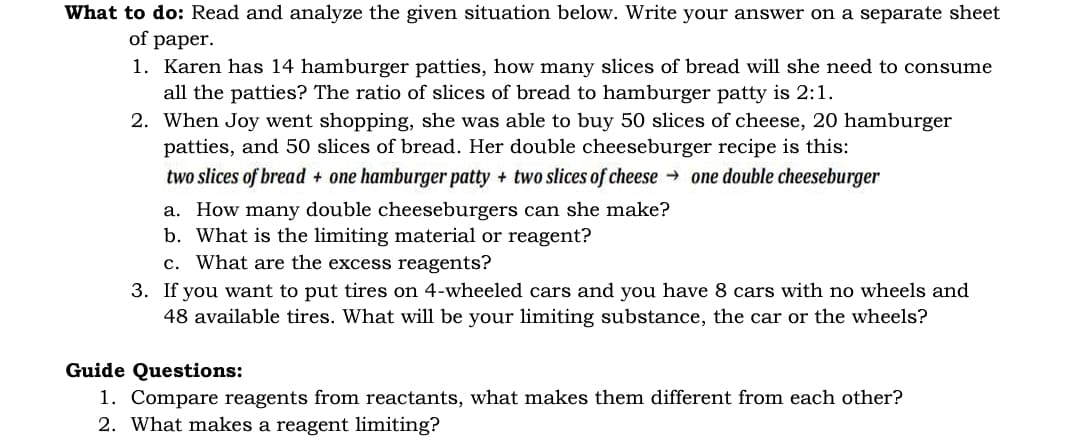What to do: Read and analyze the given situation below. Write your answer on a separate sheet of paper. 1. Karen has 14 hamburger patties, how many slices of bread will she need to consume all the patties? The ratio of slices of bread to hamburger patty is 2:1. 2. When Joy went shopping, she was able to buy 50 slices of cheese, 20 hamburger patties, and 50 slices of bread. Her double cheeseburger recipe is this: two slices of bread + one hamburger patty + two slices of cheese → one double cheeseburger a. How many double cheeseburgers can she make? b. What is the limiting material or reagent? c. What are the excess reagents? 3. If you want to put tires on 4-wheeled cars and you have 8 cars with no wheels and 48 available tires. What will be your limiting substance, the car or the wheels? Guide Questions: 1. Compare reagents from reactants, what makes them different from each other? 2. What makes a reagent limiting?
What to do: Read and analyze the given situation below. Write your answer on a separate sheet of paper. 1. Karen has 14 hamburger patties, how many slices of bread will she need to consume all the patties? The ratio of slices of bread to hamburger patty is 2:1. 2. When Joy went shopping, she was able to buy 50 slices of cheese, 20 hamburger patties, and 50 slices of bread. Her double cheeseburger recipe is this: two slices of bread + one hamburger patty + two slices of cheese → one double cheeseburger a. How many double cheeseburgers can she make? b. What is the limiting material or reagent? c. What are the excess reagents? 3. If you want to put tires on 4-wheeled cars and you have 8 cars with no wheels and 48 available tires. What will be your limiting substance, the car or the wheels? Guide Questions: 1. Compare reagents from reactants, what makes them different from each other? 2. What makes a reagent limiting?
Chemistry: The Molecular Science
5th Edition
ISBN:9781285199047
Author:John W. Moore, Conrad L. Stanitski
Publisher:John W. Moore, Conrad L. Stanitski
Chapter1: The Nature Of Chemistry
Section: Chapter Questions
Problem 33QRT
Related questions
Question
100%

Transcribed Image Text:What to do: Read and analyze the given situation below. Write your answer on a separate sheet
of paper.
1. Karen has 14 hamburger patties, how many slices of bread will she need to consume
all the patties? The ratio of slices of bread to hamburger patty is 2:1.
2. When Joy went shopping, she was able to buy 50 slices of cheese, 20 hamburger
patties, and 50 slices of bread. Her double cheeseburger recipe is this:
two slices of bread + one hamburger patty + two slices of cheese → one double cheeseburger
a. How many double cheeseburgers can she make?
b. What is the limiting material or reagent?
c. What are the excess reagents?
3. If you want to put tires on 4-wheeled cars and you have 8 cars with no wheels and
48 available tires. What will be your limiting substance, the car or the wheels?
Guide Questions:
1. Compare reagents from reactants, what makes them different from each other?
2. What makes a reagent limiting?
Expert Solution
This question has been solved!
Explore an expertly crafted, step-by-step solution for a thorough understanding of key concepts.
Step by step
Solved in 2 steps

Knowledge Booster
Learn more about
Need a deep-dive on the concept behind this application? Look no further. Learn more about this topic, chemistry and related others by exploring similar questions and additional content below.Recommended textbooks for you

Chemistry: The Molecular Science
Chemistry
ISBN:
9781285199047
Author:
John W. Moore, Conrad L. Stanitski
Publisher:
Cengage Learning



Chemistry: The Molecular Science
Chemistry
ISBN:
9781285199047
Author:
John W. Moore, Conrad L. Stanitski
Publisher:
Cengage Learning



General, Organic, and Biological Chemistry
Chemistry
ISBN:
9781285853918
Author:
H. Stephen Stoker
Publisher:
Cengage Learning

Introductory Chemistry: A Foundation
Chemistry
ISBN:
9781337399425
Author:
Steven S. Zumdahl, Donald J. DeCoste
Publisher:
Cengage Learning

Introduction to General, Organic and Biochemistry
Chemistry
ISBN:
9781285869759
Author:
Frederick A. Bettelheim, William H. Brown, Mary K. Campbell, Shawn O. Farrell, Omar Torres
Publisher:
Cengage Learning